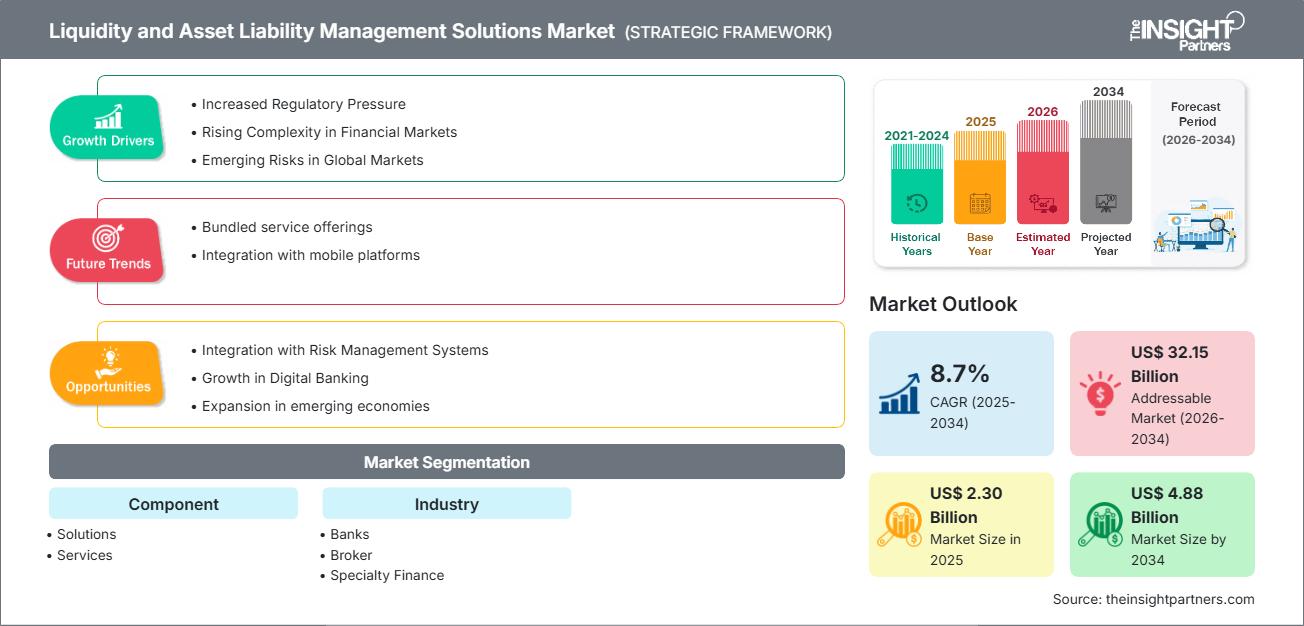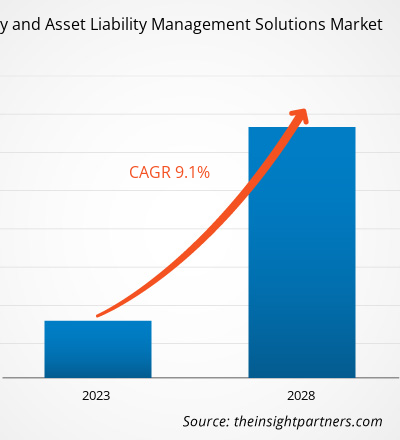유동성 및 자산부채관리(ALM) 솔루션 시장은 2025년 23억 달러에서 2034년 48억 8천만 달러로 성장할 것으로 예상되며, 예측 기간 동안 연평균 성장률(CAGR)은 8.7%입니다.
유동성 및 자산부채관리 솔루션 시장 분석
금융기관의 신용 위험 증가와 금리 위험에 대한 규제 압력 강화는 유동성 및 자산부채관리(ALM) 솔루션 시장을 견인하고 있습니다. 은행 및 기타 금융기관은 이러한 솔루션을 활용하여 시나리오 분석을 수행하고, 재무제표를 보다 효율적으로 관리하며, 강화된 자본 및 자금 조달 요건을 충족합니다. 고급 ALM 솔루션에는 다양한 사업 부문에서 수익성을 계산할 수 있는 FTP 모듈이 포함되어 있습니다.
미국, 영국, 일본 등 전 세계적으로 금리 변동성이 커지면서 순이자마진에 대한 압력이 증가했고, 이에 따라 효과적인 자산부채관리(ALM)가 매우 중요해졌습니다.
유동성 및 자산부채관리 솔루션 시장 개요
유동성 관리란 의무를 이행하기에 충분한 현금과 유동자산을 확보하는 것을 의미합니다. 반면, 자산부채관리란 자산과 부채의 만기, 이자율, 규모를 조정하여 위험을 최소화하고 수익성을 최적화하는 것을 말합니다.
유동성 및 자산부채관리(ALM) 솔루션은 금융기관이 이러한 역학 관계를 효율적으로 모델링하고 제어하여 위험 기반 의사 결정, 예측, 규정 준수 및 성과 최적화를 가능하게 합니다.
이 보고서를 귀하의 요구사항에 맞게 맞춤 설정하십시오.
모든 보고서에 대한 맞춤형 서비스(본 보고서의 일부 또는 국가별 분석, Excel 데이터 팩 포함)를 무료로 제공해 드립니다. 또한 스타트업 및 대학을 위한 다양한 할인 혜택도 누리실 수 있습니다.
유동성 및 자산부채관리 솔루션 시장: 전략적 분석

-
이 보고서에서 주요 시장 동향을 확인하세요.이 무료 샘플에는 시장 동향부터 추정치 및 예측에 이르기까지 다양한 데이터 분석이 포함됩니다.
유동성 및 자산부채관리 솔루션 시장 동인 및 기회
시장 동인:
- 금융기관의 신용 위험 증가: 부실률 증가, 부실 대출 포트폴리오, 불확실한 거시 경제 환경으로 인해 금융기관들은 유동성 및 금리 위험 관리를 위한 솔루션을 도입하고 있습니다.
- 규제 압력: IRRBB(은행 장부의 금리 위험), 자금 조달 계획 스트레스 테스트 및 자본 위험 프레임워크를 포함한 대부분의 규제는 은행이 정교한 자산부채관리(ALM) 모델을 실행하도록 요구합니다.
- 변동성이 큰 금리 환경: 글로벌 금리 변동성은 마진을 압박하고, 따라서 수익성을 보호하기 위한 효과적인 자산부채관리(ALM)의 필요성을 증가시킵니다.
- 디지털화 및 분석: 기관들은 자산부채관리(ALM)에서 데이터 분석, 시나리오 시뮬레이션, 예측을 기반으로 의사결정을 내리는 경우가 점점 더 많아지고 있습니다.
기회:
- AI/머신러닝을 활용한 리스크 모델링: 고급 AI 기반 ALM 도구는 예측, 유동성 스트레스 테스트 및 시나리오 관리를 개선할 수 있습니다.
- 클라우드 기반 ALM 플랫폼: 클라우드 배포는 기관이 인프라 비용을 절감하면서 ALM 시스템을 더욱 유연하게 확장하는 데 도움이 될 수 있습니다.
- 재무 시스템과의 통합: ALM 도구는 재무, 위험 관리 및 자금 이체 가격 책정 시스템과 통합되어 통합된 의사 결정 프레임워크를 구축할 수 있습니다.
- 신흥 시장 확장: 아시아 태평양 지역과 같은 신흥 경제국의 은행들이 성장함에 따라, 고급 유동성 및 자산부채관리(ALM) 솔루션에 대한 수요가 증가하고 있습니다.
유동성 및 자산부채관리 솔루션 시장 보고서 세분화 분석
구성 요소별:
- 솔루션
- 서비스
산업/기관 유형별:
- 은행
- 브로커
- 특수 금융
- 자산관리사
- 기타
지리학별:
- 북아메리카
- 유럽
- 아시아태평양
- 남미 및 중앙아메리카
- 중동 및 아프리카
유동성 및 자산부채관리 솔루션 시장 지역별 분석
인사이트 파트너스의 분석가들은 예측 기간 동안 유동성 및 자산 부채 관리 솔루션 시장에 영향을 미치는 지역별 동향과 요인을 자세히 설명했습니다. 이 섹션에서는 북미, 유럽, 아시아 태평양, 중동 및 아프리카, 남미 및 중앙아메리카를 아우르는 유동성 및 자산 부채 관리 솔루션 시장 세분화 및 지역별 분석도 다룹니다.
유동성 및 자산부채관리 솔루션 시장 보고서 범위
| 보고서 속성 | 세부 |
|---|---|
| 2025년 시장 규모 | 23억 달러 |
| 2034년 시장 규모 | 48억 8천만 달러 |
| 글로벌 연평균 성장률(2025년~2034년) | 8.7% |
| 역사적 데이터 | 2021-2024 |
| 예측 기간 | 2026-2034 |
| 포함되는 부문 |
구성 요소별
|
| 대상 지역 및 국가 |
북아메리카
|
| 시장 선도 기업 및 주요 기업 프로필 |
|
유동성 및 자산부채관리 솔루션 시장 참여자 밀도: 비즈니스 역학에 미치는 영향 이해
유동성 및 자산부채관리 솔루션 시장은 소비자 선호도 변화, 기술 발전, 제품 이점 인식 제고 등 여러 요인으로 인한 최종 사용자 수요 증가에 힘입어 빠르게 성장하고 있습니다. 수요 증가에 따라 기업들은 제품 및 서비스 범위를 확장하고, 소비자 요구를 충족하기 위한 혁신을 추진하며, 새로운 트렌드를 활용하여 시장 성장을 더욱 촉진하고 있습니다.

- 유동성 및 자산부채관리 솔루션 시장의 주요 업체 개요를 확인하세요.
유동성 및 자산부채관리 솔루션 시장 점유율 분석 (지역별)
- 북미 지역: 선진적인 은행 인프라, 고도화된 규제 체계, 그리고 통합 위험 관리 플랫폼에 대한 수요에 힘입어 강력한 도입세를 보이고 있습니다.
- 유럽: 규제 요구와 고도화된 금융 기관들이 자산부채관리(ALM) 도입을 주도하고 있으며, 스트레스 테스트와 금리 위험 관리 의무가 핵심 요소입니다.
- 아시아 태평양 지역: 빠르게 성장할 것으로 예상되는 지역입니다. 은행 부문의 규모 확대, 디지털 전환, 그리고 위험 인식 제고가 자산부채관리(ALM)에 대한 수요를 촉진하고 있습니다.
- 남미 및 중미: 성장하는 은행 부문의 위험 관리 요구에 힘입어 자산부채관리(ALM)의 신흥 시장으로 부상하고 있습니다.
- 중동 및 아프리카: 금융 서비스 이용 증가와 규제 성숙도는 ALM 솔루션 제공업체에게 기회를 제공합니다.
유동성 및 자산부채관리 솔루션 시장 참여자 밀도: 비즈니스 역학에 미치는 영향 이해
유동성 및 자산부채관리(ALM) 솔루션 시장에서 경쟁이 심화되고 있습니다. 주요 업체로는 대형 글로벌 금융 소프트웨어 기업뿐 아니라 지역 전문 업체들도 있습니다. 차별화를 위해 벤더들은 다음과 같은 전략을 사용합니다.
- FTP, 시나리오 분석 및 스트레스 테스트를 포함한 통합 ALM 및 유동성 위험 관리 플랫폼을 제공합니다.
- 분석, 인공지능 및 예측 모델링을 통합하여 미래 지향적인 위험 통찰력을 제공합니다.
- 클라우드 기반 ALM 서비스를 제공하여 도입 비용을 절감하고 확장성을 향상시킵니다.
- 은행 및 금융 기관과 협력하여 현지 규제 및 시장 요구에 맞춰 자산부채관리(ALM) 시스템을 맞춤화합니다.
유동성 및 자산부채관리(ALM) 솔루션 시장에서 활동하는 주요 기업:
- Experian Information Software, Inc.
- 피델리티 내셔널 인포메이션 서비스 주식회사
- 피나스트라 인터내셔널 리미티드
- IBM 주식회사
- 인포시스 주식회사
- 인텔렉트 디자인 아레나 리미티드
- 무디스 코퍼레이션
- 오라클 코퍼레이션
- SAP SE
연구 과정에서 분석된 기타 회사들
- FIS 글로벌
- SAS 연구소, 주식회사
- 피서브 주식회사
- 액센츄어 PLC
- KPMG LLP
- 딜로이트
- PwC
- 아이
- 프로티비티 주식회사
- 알바레즈 & 마살
유동성 및 자산부채관리 솔루션 시장 뉴스 및 최근 동향
- 디지털 전환 이니셔티브: 금융 기관들은 유동성 예측 및 위험 관리를 개선하기 위해 실시간 분석, 클라우드 기반 자산부채관리(ALM), 인공지능 기반 도구를 점점 더 많이 활용하고 있습니다.
- 규제 스트레스 테스트 요구 사항: 전 세계적으로 자본 및 유동성 규제가 강화됨에 따라 은행들은 규제 스트레스 테스트, 은행 장부의 금리 위험(IRRBB) 및 자금 이전 가격 책정을 지원하는 자산부채관리(ALM) 시스템에 대한 투자를 늘리고 있습니다.
- 파트너십 및 구현: 예를 들어, 2022년 6월 Infosys Finacle(EdgeVerve)은 한 은행에 재무 및 자산부채관리(ALM) 플랫폼을 구현하여 통합 위험-유동성 시스템의 배포 사례를 보여주었습니다.
유동성 및 자산부채관리 솔루션 시장 보고서 범위 및 제공 내용
Insight Partners의 "유동성 및 자산 부채 관리 솔루션 시장 규모 및 전망(2021~2034)" 보고서에는 다음 내용이 포함됩니다.
- 글로벌, 지역 및 국가별 주요 부문의 시장 규모 및 전망
- 시장 동향 상세 분석: 동인, 제약 요인 및 기회
- PEST 및 SWOT 분석
- 전략적 통찰: 트렌드, 규제 영향 및 경쟁 분석
- 산업 현황: 시장 집중도, 주요 기업 히트맵, 최근 전략적 움직임
- 선도적인 ALM 솔루션 제공업체 및 신흥 솔루션 제공업체에 대한 상세 기업 프로필
- 과거 분석(2년), 기준 연도, CAGR을 포함한 예측(7년)
- PEST 및 SWOT 분석
- 시장 규모 가치/거래량 - 글로벌, 지역, 국가
- 산업 및 경쟁 환경
- Excel 데이터세트
최근 보고서
사용 후기
구매 이유
- 정보에 기반한 의사 결정
- 시장 역학 이해
- 경쟁 분석
- 고객 인사이트
- 시장 예측
- 위험 완화
- 전략 기획
- 투자 타당성 분석
- 신흥 시장 파악
- 마케팅 전략 강화
- 운영 효율성 향상
- 규제 동향에 발맞춰 대응






















 무료 샘플 받기 - 유동성 및 자산부채관리 솔루션 시장
무료 샘플 받기 - 유동성 및 자산부채관리 솔루션 시장